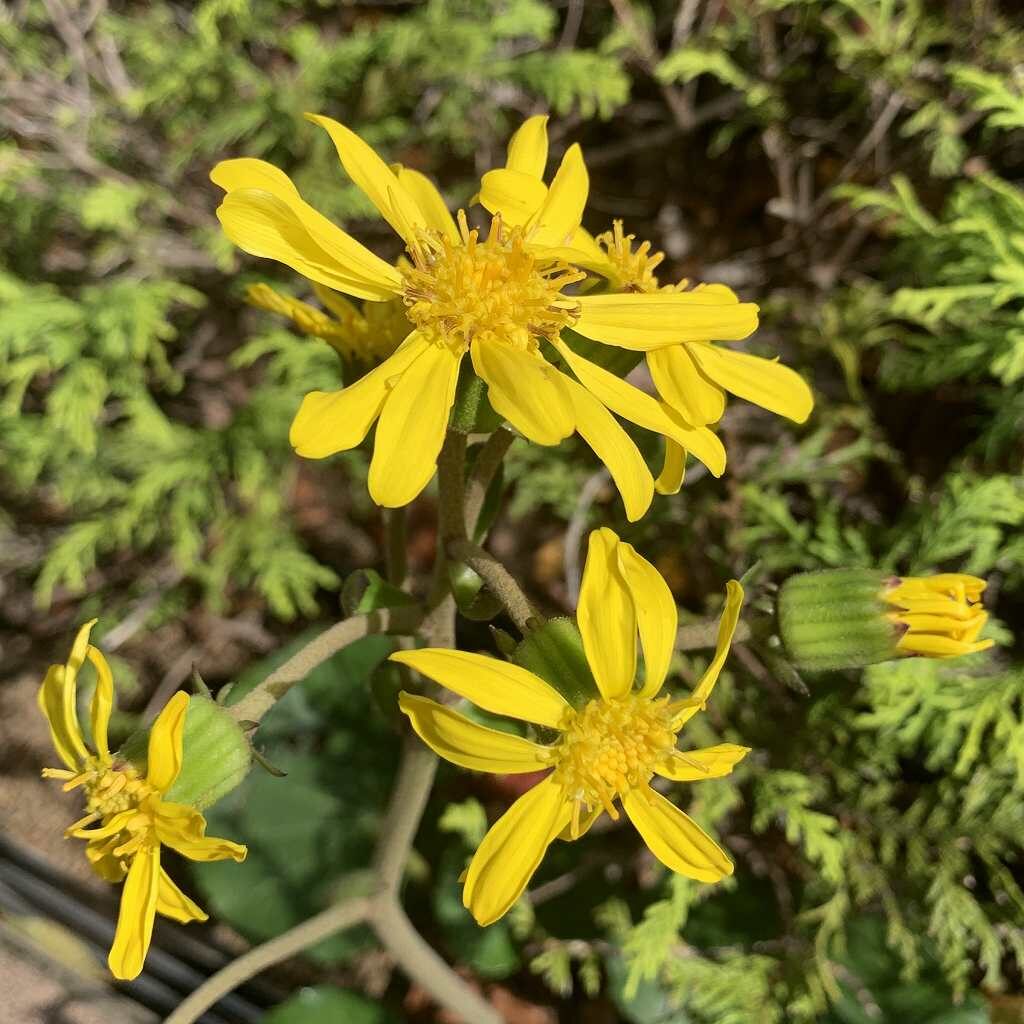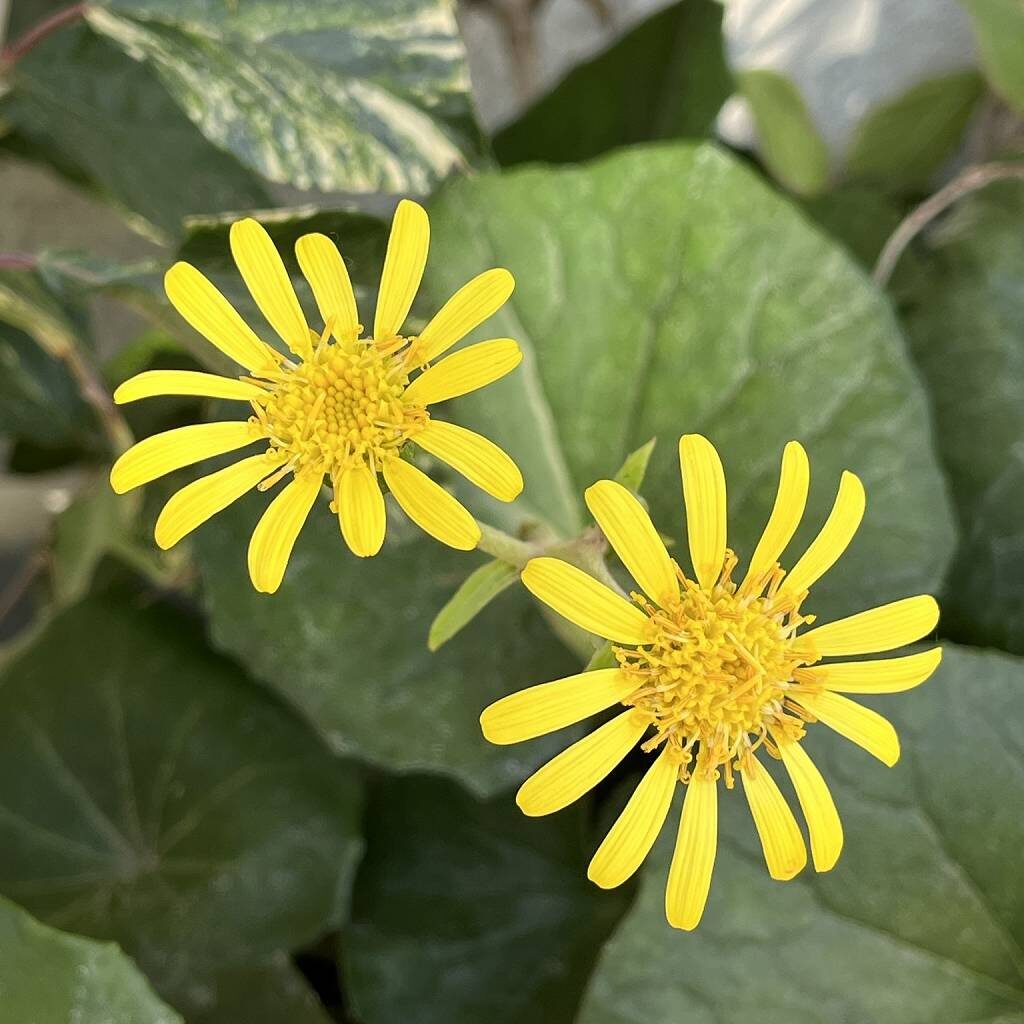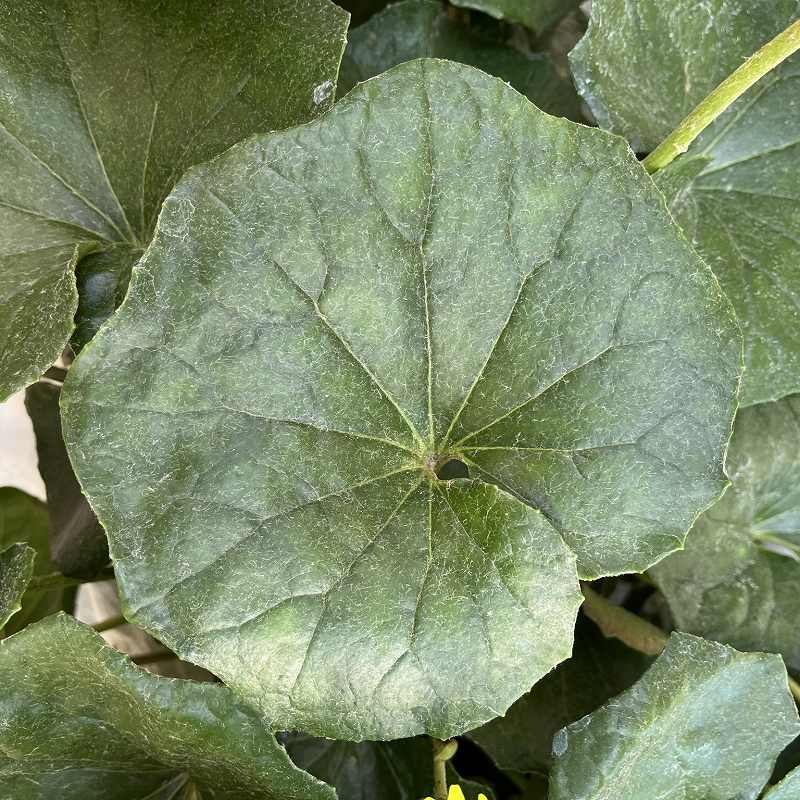ツワブキは海岸近くの岩場や山地の林縁など、あまり陽がささないところで自生。庭園にも植えられ、初冬に鮮やかな黄色の花を咲かせます。
Leopard Plant grows naturally in places where the sun doesn’t shine much, such as rocky areas near the coast and forest edges in mountains. It is also planted in gardens and blooms bright yellow flowers in early winter.
【仮名】ツワブキ
【和名】石蕗
【英名】Leopard Plant, Japanese Silver Leaf
【学名】Farfugium japonicum
【誕生】11/ 20, 11/ 30, 12/ 03, 12/ 05
【開花】10, 11, 12月
【花色】Yellow



ツワブキ
ツワブキの生態
ツワブキはキク科の多年草です。日本海側の石川県、太平洋側の福島県より西の本州、四国、九州、南西諸島、国外では朝鮮半島、中国、台湾に分布し、海岸近くの岩場や山地の林縁など、あまり陽がささないところで自生。庭園にも植えられ、初冬に鮮やかな黄色の花を咲かせます。
ツワブキの名前
ツワブキの名前の由来は、葉の姿形が同じキク科の「蕗」に似ていて、表面に光沢があるから。「艶蕗」が転じて「石蕗」です。蕗と同様、大きく切れ込んだ丸い葉身の真ん中から長い葉柄が伸びるものの、蕗はフキ属なので遠縁。冬の間、蕗は葉を落とし、石蕗は葉を落としません。
ツワブキの姿形
ツワブキの葉は地中の根茎から直に伸び、褐色の毛に覆われて丸まった若葉が展開すると無毛になります。丸い腎臓形で葉柄が長く、葉身が厚く、表面に光沢。花は菊に似て、周りが雌性の舌状花、真ん中が両性の筒状花です。花後の痩果は褐色の冠毛がついた種子を風に乗せて散布。
ツワブキの近縁
ツワブキの変種「大石蕗」は、九州の西海岸で自生し、草丈が高く、葉も花も大型です。「琉球石蕗」は琉球諸島の奄美大島から西表島まで渓流に自生し、葉が扇形または菱形。「台湾石蕗」は「台灣山菊」とも呼ばれて台湾本島の高地で自生し、葉の縁が緩く尖りながら波打ちます。
ツワブキの利用
ツワブキは葉が固くなる前の若葉が食用に。湯通しして表皮を剥いて切り、水に晒して灰汁を抜き、金平や和え物のほか、伽羅蕗などでいただきます。また、生葉を揉んで患部に貼ったり、搾って飲んだり、干して煎じるなどして薬用にも。腫れものや打撲、火傷などに用いられます。
Leopard Plant
Leopard Plant is a perennial of the Asteraceae family. Distributed in Honshu to the west of Ishikawa Prefecture on the Sea of Japan side or Fukushima Prefecture on the Pacific Ocean side, Shikoku, Kyushu, and the Nansei Islands. Outside of Japan, it is distributed in the Korean Peninsula, China, and Taiwan. It is also planted in gardens and has bright yellow flowers in early winter.
The Japanese name of Leopard Plant means that the shape of the leaves resembles butterbur, which belongs to the same Asteraceae family, and has a glossy surface. Like butterbur, it has a long petiole extending from the center of the large, rounded leaf blade, but it is distantly related to butterbur because it belongs to the genus Petasites. During the winter, the butterbur sheds its leaves, and the Leopard Plant does not shed its leaves.
Leopard Plant leaves grow straight from underground rhizomes, and the young leaves are curled with brown hairs, which become glabrous when unfolded. The leaves are round, kidney-shaped, with long petioles, thick leaf blades, and a glossy surface. The flowers are similar to chrysanthemums, with female ray flowers around and bisexual tubular flowers in the middle. Achenes after flowering are scattered by the wind with brown pappus seeds.
The “Giganteum”, a variety of Leopard Plant, grows naturally on the west coast of Kyushu, and has a tall plant with large leaves and flowers. “Luchuense” grows naturally in mountain streams from Amami Oshima to Iriomote Island in the Ryukyu Islands, and has fan-shaped or diamond-shaped leaves. “Formosanum”, also called “Taiwan mountain chrysanthemum”, grows naturally in the highlands of the main island of Taiwan.
The young leaves of Leopard Plant are edible before the leaves harden. It is blanched, the skin is peeled off, cut into pieces, soaked in water to remove the lye, and eaten as Kinpira, Aemono, or Carabuki. It can also be used for medicinal purposes by rubbing the fresh leaves and applying them to the affected area, squeezing and drinking, drying and brewing. It is used for swelling, bruises and burns.


